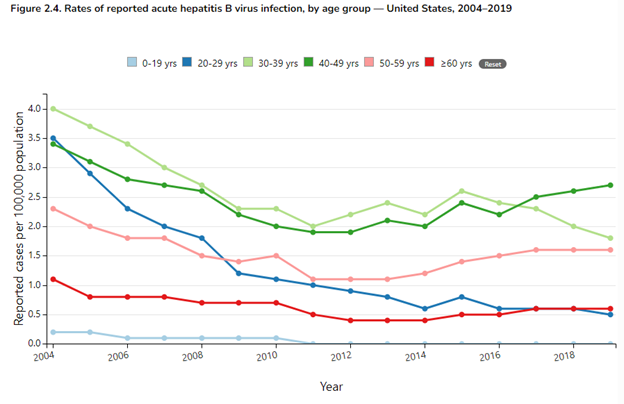Vaccine Update: Staying Current with Hepatitis B Recommendations
Column Author: Maria A. Martinez MSN, MBA, RN, CPN
Column Editor: Douglas S. Swanson, MD | Medical Director, Occupational Health
Globally, viral hepatitis infections result in 3,500 deaths each day.1 The World Health Organization (WHO) estimates that in 2022, there were 254 million people living with chronic hepatitis B. In 2022, 1.1 million deaths were caused by hepatitis B. Most of those deaths were from cirrhosis and hepatocellular carcinoma. It is estimated that there are 1.2 million new infections every year.2

The United States has an estimated 880,000 to 1.89 million people with chronic hepatitis B infection.3 Introduction of the first hepatitis B vaccine in the 1980s targeted high-risk populations such as healthcare workers, patients on dialysis, and intravenous drug users. Unfortunately, because this disease is so contagious, this strategy was not effective and hepatitis B rates remained nearly unchanged. In 1991, immunization recommendations were expanded to include all infants and young children. Despite some initial resistance to the immunization recommendations,4 this strategy was successful in eliminating nearly all cases of hepatitis B virus (HBV) infection in children 0-19 years of age.5 In 2019, approximately 50% of acute hepatitis B cases reported that year were in persons 30-49 years of age. Cases also increased for adults 40-59 years of age. In 2022, in an effort to improve adult vaccination rates for hepatitis B, the Advisory Committee on Immunization Practices (ACIP) expanded its recommendation for vaccination to include all adults aged 19-59 years of age. Previous risk factor-based approaches to vaccination recommendation for hepatitis B in adults led to suboptimal coverage.6

Hepatitis B is a very prevalent disease; it is highly contagious and transmissible. The main method of transmission is through contact with infected body fluids such as blood or semen. Individuals with chronic HBV have such high concentrations of virus in their blood that they can transmit the virus with amounts of blood that are not visible to the eye. Even sharing items such as a toothbrush, towel or razor can lead to infection.5 Infections can be acute or chronic. Chronic hepatitis B infection is treatable, but not curable. Disease complications can include chronic liver infection, liver failure and liver cancer.
Hepatitis B can be prevented through vaccination. The vaccine is safe and effective yielding nearly 100% protection against infection from the virus.2 In the United States there are several hepatitis B vaccines. The Centers for Disease Control and Prevention’s updated 2024 Immunization Schedule for children and adults reflects the most up-to-date recommendations for hepatitis B vaccination. For guidance on different hepatitis vaccine products click here. Ensure that you are reviewing patient vaccination history for hepatitis B in the following patients (if status is unknown, vaccinate):
- All infants, children and adolescents younger than 19 years of age
- All adults 19-59 years of age
- Adults 60 years of age or older
- Without known risk factors may receive the vaccination
- With known risk factors should receive the vaccination
If your clinical practice does not carry hepatitis B vaccine, refer patients to their local health department, county health department, or pharmacies to inquire about product availability. Many health departments will be able to provide vaccination to those who are uninsured or underinsured through the 317 program as well as to those with insurance. Patients who have health insurance marketplace plans and most private insurance plans will have most vaccines covered through their plan – hepatitis B being one of the covered vaccines.7
References:
- WHO sounds alarm on viral hepatitis infections claiming 3500 lives each day. News release. World Health Organization. April 9, 2024. Accessed May 29, 2024. https://www.who.int/news/item/09-04-2024-who-sounds-alarm-on-viral-hepatitis-infections-claiming-3500-lives-each-day
- Hepatitis B. World Health Organization. April 9, 2024. Accessed May 29, 2024. https://www.who.int/news-room/fact-sheets/detail/hepatitis-b
- Hepatitis B basic information. U.S. Department of Health and Human Services. Last reviewed March 31, 2023. Accessed May 29, 2024. https://www.hhs.gov/hepatitis/learn-about-viral-hepatitis/hepatitis-b-basics/
- Freed GL, Bordley WC, Clark SJ, Konrad TR. Universal hepatitis B immunization of infants: reactions of pediatricians and family physicians over time. Pediatrics. 1994;93(5):747-51. PMID: 8165072.
- A look at each vaccine: hepatitis B vaccine. Children’s Hospital of Philadelphia. Last reviewed May 13, 2022. Accessed May 29, 2024. https://www.chop.edu/centers-programs/vaccine-education-center/vaccine-details/vaccine-hepatitis-b-vaccine
- Weng MK, Doshani M, Khan MA, et al. Universal hepatitis B vaccination in adults aged 19-59 Years: updated recommendations of the Advisory Committee on Immunization Practices - United States, 2022. MMWR Morb Mortal Wkly Rep. 2022;71(13):477-483. Accessed May 28, 2024. https://www.cdc.gov/mmwr/volumes/71/wr/mm7113a1.htm
- How to pay for adult vaccines. Centers for Disease Control and Prevention. Last reviewed September 28, 2023. Accessed May 30, 2024: https://www.cdc.gov/vaccines/adults/pay-for-vaccines.html
